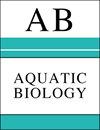Assigning functional feeding groups to aquatic arthropods in a Neotropical mountain river
IF 1.3
4区 生物学
Q3 MARINE & FRESHWATER BIOLOGY
引用次数: 5
Abstract
The importance of aquatic arthropods in the processing of organic matter in fluvial systems is well known, but this topic has been poorly studied in Neotropical rivers. In this research, we studied the composition of functional feeding groups (FFGs) associated with differences in elevation in a tropical river in northern Colombia during the wet and dry seasons. Between 2008 and 2013, we collected benthic arthropods at 3 sites located in the upper (San Lorenzo), intermediate (La Victoria) and lower (Puerto Mosquito) sections of the Gaira River. We found some differences in the gut contents and FFGs of the animals from different sites and between the climatic seasons. The dominant food source at all the sites and during both seasons was fine particulate organic matter (FPOM). At La Victoria, the genera Leptonema, Smicridea and Phylloicus (all belonging to Trichoptera) presented significant differences in the consumption of coarse particulate organic matter (CPOM) between the rainy and dry seasons (p < 0.05). At San Lorenzo, Leptonema had the highest animal tissue consumption value (p < 0.05). A discriminant function analysis based on gut contents suggested that some taxa may have been assigned to the wrong FFGs. We concluded that the diets of the aquatic arthropods in our study tended to present high trophic plasticity. Consequently, our results suggest that Neotropical rivers need to be reevaluated in terms of traditionally established FFGs, which heretofore have been based on in formation from other regions of the world, producing incorrect assessments of aquatic systems.新热带山区河流中水生节肢动物功能摄食群的划分
水生节肢动物在河流系统有机物加工中的重要性是众所周知的,但这一主题在新热带河流中的研究很少。在这项研究中,我们研究了哥伦比亚北部热带河流在干湿季节与海拔差异相关的功能摄食群(ffg)的组成。2008年至2013年,我们在盖拉河上游(圣洛伦佐)、中游(维多利亚)和下游(蚊子港)3个地点采集了底栖节肢动物。我们发现来自不同地点和不同气候季节的动物的肠道内容物和ffg存在一些差异。所有样点和两个季节的主要食物来源都是细颗粒物有机质(FPOM)。在La Victoria, Leptonema、Smicridea和Phylloicus属(均属于毛翅目)的粗颗粒有机质(CPOM)消耗在雨季和旱季之间存在显著差异(p < 0.05)。在圣洛伦佐,Leptonema的动物组织消耗值最高(p < 0.05)。基于肠道内容物的判别函数分析表明,一些分类群可能被分配给了错误的ffg。我们得出结论,在我们的研究中,水生节肢动物的饮食倾向于呈现高营养可塑性。因此,我们的研究结果表明,新热带河流需要根据传统建立的ffg进行重新评估,这些ffg迄今为止基于世界其他地区的信息,对水生系统进行了不正确的评估。
本文章由计算机程序翻译,如有差异,请以英文原文为准。
求助全文
约1分钟内获得全文
求助全文
来源期刊

Aquatic Biology
生物-海洋与淡水生物学
CiteScore
2.70
自引率
0.00%
发文量
7
审稿时长
3 months
期刊介绍:
AB publishes rigorously refereed and carefully selected Feature Articles, Research Articles, Reviews and Notes, as well as Comments/Reply Comments (for details see MEPS 228:1), Theme Sections, Opinion Pieces (previously called ''As I See It'') (for details consult the Guidelines for Authors) concerned with the biology, physiology, biochemistry and genetics (including the ’omics‘) of all aquatic organisms under laboratory and field conditions, and at all levels of organisation and investigation. Areas covered include:
-Biological aspects of biota: Evolution and speciation; life histories; biodiversity, biogeography and phylogeography; population genetics; biological connectedness between marine and freshwater biota; paleobiology of aquatic environments; invasive species.
-Biochemical and physiological aspects of aquatic life; synthesis and conversion of organic matter (mechanisms of auto- and heterotrophy, digestion, respiration, nutrition); thermo-, ion, osmo- and volume-regulation; stress and stress resistance; metabolism and energy budgets; non-genetic and genetic adaptation.
-Species interactions: Environment–organism and organism–organism interrelationships; predation: defenses (physical and chemical); symbioses.
-Molecular biology of aquatic life.
-Behavior: Orientation in space and time; migrations; feeding and reproductive behavior; agonistic behavior.
-Toxicology and water-quality effects on organisms; anthropogenic impacts on aquatic biota (e.g. pollution, fisheries); stream regulation and restoration.
-Theoretical biology: mathematical modelling of biological processes and species interactions.
-Methodology and equipment employed in aquatic biological research; underwater exploration and experimentation.
-Exploitation of aquatic biota: Fisheries; cultivation of aquatic organisms: use, management, protection and conservation of living aquatic resources.
-Reproduction and development in marine, brackish and freshwater organisms
 求助内容:
求助内容: 应助结果提醒方式:
应助结果提醒方式:


